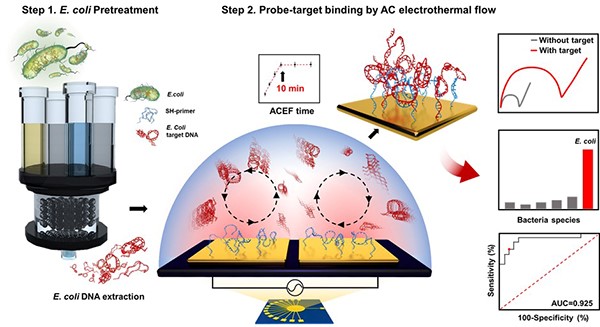Prof. Taek Lee and His Research Team Develop an Integrated On-site DNA Pre-treatment Device
- admin
- 2024-10-15
- 1406
· Prof. Taek Lee (Department of Chemical Engineering) and His Research Team Develop an Integrated On-site DNA Pre-treatment Device and High-speed Biosensor System for Detecting E. coli in Milk
·
Prof. Taek Lee (Department of Chemical Engineering) and His Research Team
Develop an Integrated On-site DNA
Pre-treatment Device and High-speed Biosensor System for Detecting E. coli in
Milk
- Simplification of on-site DNA pre-treatment methods
for E. coli and integration with a high-speed detection biosensor system -
- Demonstration of the field applicability of a
biosensor using DNA extracted with the developed pre-treatment device -
- Published in the renowned international journal Chemical
Engineering Journal (IF: 13.3, JCR: 3.8%) -
The research team of Professor Taek
Lee from the Department of Chemical Engineering, along with graduate student
Ye-Jin Yoon, developed an integrated on-site DNA pre-treatment device and
high-speed detection biosensor system. The developed pre-treatment device could
rapidly extract DNA from E. coli in milk within 20 minutes, and when applied to
an AC electrothermal flow (ACEF)-based biosensor, it established an integrated
pre-treatment-biosensor detection system capable of detecting within 10
minutes.

E. coli is a common and dangerous foodborne pathogen
that causes various diseases in humans and animals, leading to bloody diarrhea,
kidney failure, and even death in severe cases. It accounts for 20% of food
poisoning cases globally. E. coli-related food poisoning often occurs due to
the consumption of contaminated water or food, with contaminated dairy products
being the leading cause of hospitalization due to foodborne illnesses. Since
milk, which contains various nutrients, provides an ideal environment for the
proliferation of even small amounts of E. coli, a system capable of rapidly
detecting and monitoring E. coli during milk processing is essential. In
response, Professor Lee’s team developed an integrated DNA pre-treatment and
electrochemical biosensor system that can quickly detect E. coli in milk.
Single-stranded DNA (ssDNA), the fundamental material
of biological genetics, can be designed with a specific sequence that targets a
substance, allowing for sensitive and selective detection when applied as a
receptor in biosensors. ssDNA can be easily functionalized and immobilized on
biosensors using various covalent bonding technologies. Additionally, it
provides high sensitivity in electrochemical analysis when binding to target
DNA, enabling quantitative detection of the target using electrochemical
methods. However, the pre-treatment step required to extract DNA from E. coli
in complex matrices like milk can take a long time due to its various
procedures.
To establish a rapid detection platform for on-site
detection of E. coli, Professor Lee's team developed a pre-treatment device
that controls reagents with valves to enable sequential reactions, which was
then integrated with a DNA-based electrochemical biosensor. The pre-treatment
device consists of a chamber filled with glass beads coated with tetraethyl
orthosilicate (TEOS) and valves to control the reagents, effectively removing
E. coli residues. Milk containing E. coli passes through the chamber, and after
controlling the valves to extract DNA, nucleic acids are released and
fragmented through subsequent physical treatments. The extracted target DNA of
E. coli is applied to the biosensor for electrochemical performance evaluation.
The ssDNA, designed using a highly variable genetic sequence identified through
genetic analysis of E. coli, was applied as a receptor in the biosensor,
showing sensitive electrochemical signal changes upon binding to the DNA
extracted by the pre-treatment device.
To shorten the target binding time for the biosensor,
the ACEF method was introduced, reducing detection time to 10 minutes and
demonstrating 97.334% accuracy compared to natural diffusion over 24 hours,
proving the reliability of rapid detection. The sensor was evaluated using
electrochemical impedance spectroscopy (EIS), and a more sensitive signal
change was observed with the developed pre-treatment device compared to nucleic
acids extracted using a commercial pre-treatment kit. The biosensor operated
linearly in the range of 10E-04 to 1 ng/μL, with detection limits of 9.883 ×
10E-5 ng/μL in DIW and 9.235 × 10E-5 ng/μL in real milk, demonstrating
sensitive detection performance. Additionally, the matrix effect due to the
presence of Salmonella typhimurium, another common foodborne pathogen, was
7.425%, indicating sensitive signal changes corresponding to E. coli
concentration despite the presence of interfering species. A false-positive
test conducted on 20 negative and 20 positive samples in real spoiled milk
demonstrated a high accuracy of 92.5% in distinguishing false positives. The
critical signal value for negative/positive detection was 24.360 kΩ, and the
sensor exhibited high sensitivity and selectivity, with 90% sensitivity and 85%
selectivity. As a result, the developed pre-treatment-integrated E. coli
detection biosensor successfully detected E. coli in real milk with high
sensitivity and accuracy within 30 minutes, providing an effective platform for
E. coli detection. This study is significant as the first to integrate a
pre-treatment device and biosensor for rapid E. coli detection, proving the
potential for real-world application and suggesting the sensor’s use as a
highly effective pathogen detection platform. The pre-treatment-biosensor
system developed by Professor Lee's team shows broad potential as a platform for
detecting not only E. coli but also various harmful bacteria.
This
study was supported by the Ministry of Environment of Korea (MOE) through the
Korea Environmental Industry & Technology Institute (2020003030001) and by
the National Research Foundation of Korea (2021R1C1C1005583), as well as by the
National Research Council of Science & Technology (CRC22021-200). The
research results were published in the renowned international journal Chemical
Engineering Journal (IF: 13.3, JIF ranking: 96.2%) under the title
"Construction of on-site DNA pre-treatment device and rapid
electrochemical biosensor set for Escherichia coli detection in milk"
(DOI: https://doi.org/10.1016/j.cej.2024.155898). (DOI: https://doi.org/10.1016/j.cej.2024.155898)